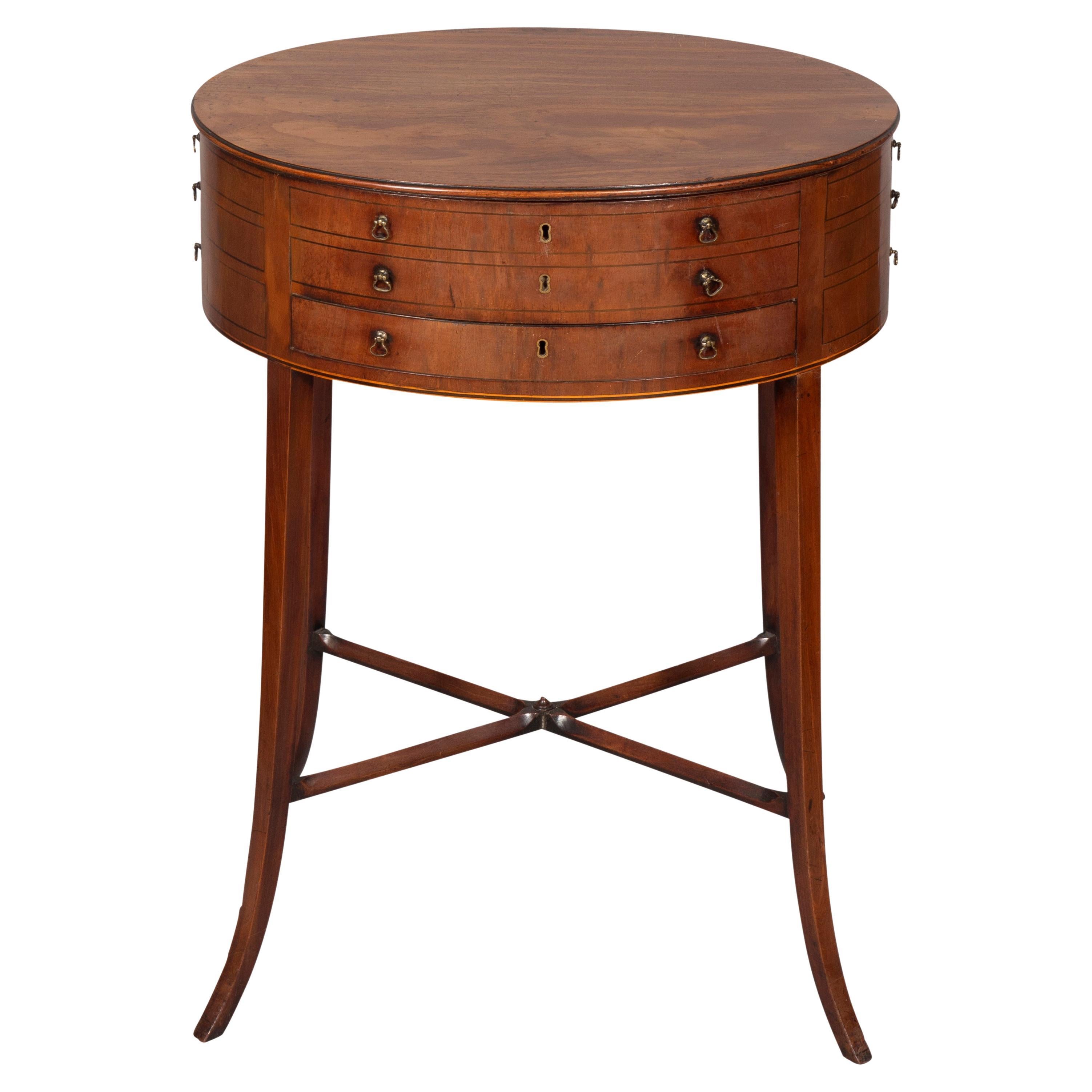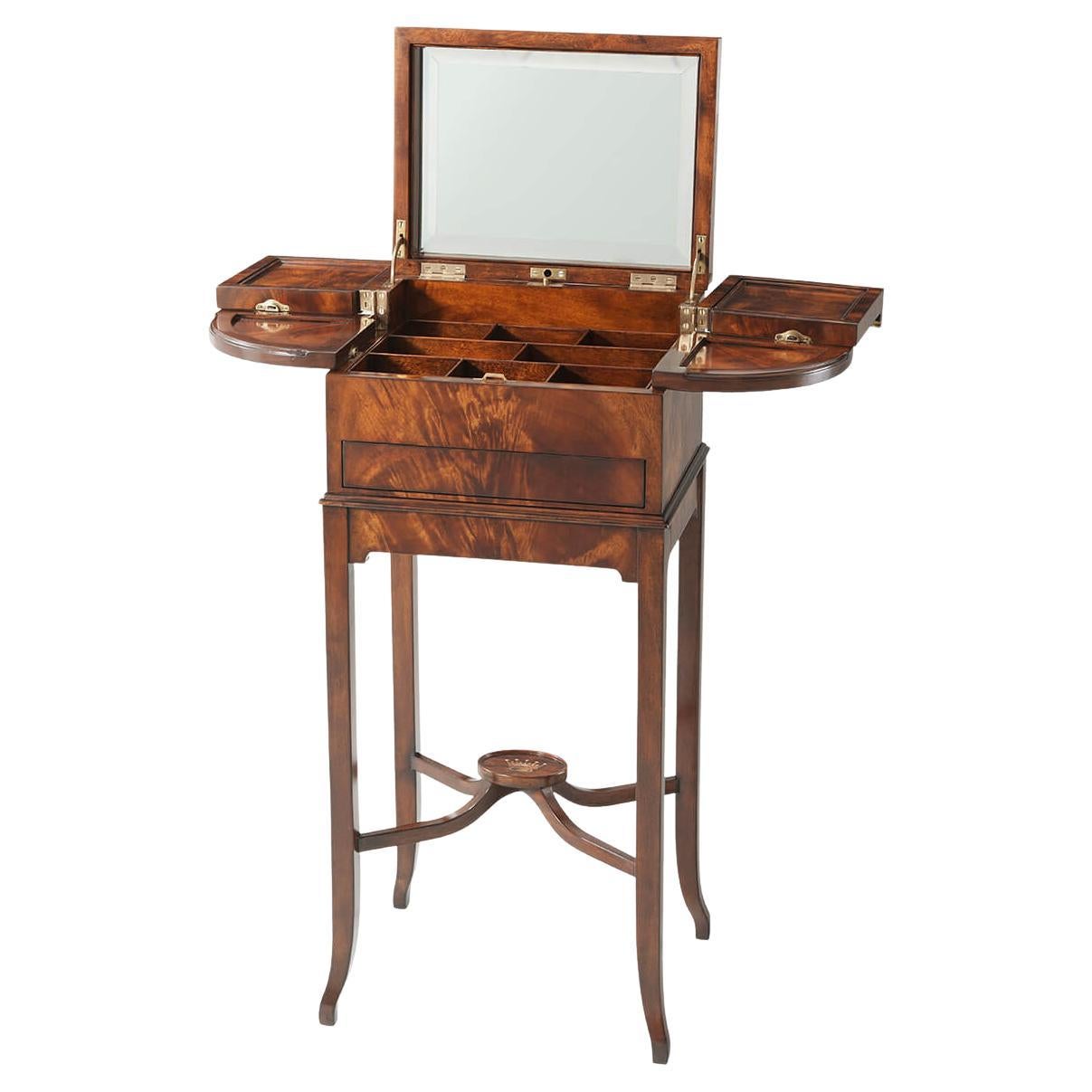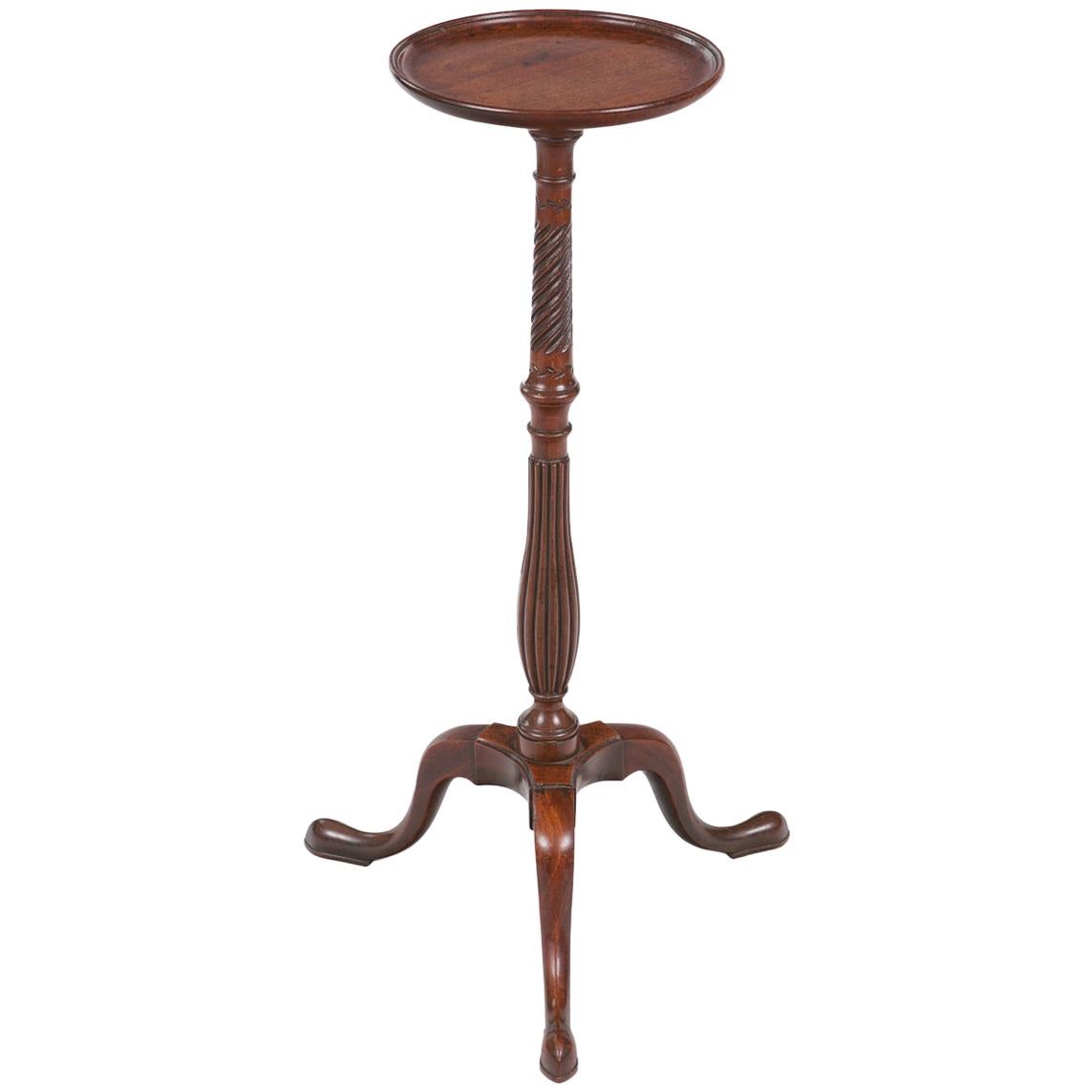Items Similar to George III Serpentine Inlaid Writing Dressing Table
Video Loading
Want more images or videos?
Request additional images or videos from the seller
1 of 14
George III Serpentine Inlaid Writing Dressing Table
About the Item
A George III period sabicu and goncalo alves serpentine writing / dressing table. In the manner of master cabinet-maker Pierre Langlois, circa 1770.
Great color, condition and surface patination.
The serpentine top inset with a blue, gilt-tooled leather writing surface.
The frieze with one long silk-lined, side-fitted cockbeaded drawer below a simulated slide.
The reverse simulated to match with a working slide to the front, also fitted with a blue tooled-leather writing surface. Raised on elegant slender cabriole legs in the French taste, with four sabicu-inlaid reserves, and united by a concave-fronted platform stretcher. The reverse with a rising slide fitted with a pleated blue silk panel. Apparently retaining its original brass mounts.
This lovely English table would make a useful small side table / lamp table / occasional table. Attributable to John Cobb (c.1710–1778), a notable English cabinetmaker.
Measures:
Height 29.5" (75 cm)
Width 25" (63 cm) max
Depth 17" (43 cm).
A closely related antique writing table, lacking its screen, sold at Christies, London 13th April, 1989, lot 68, for £7,700.00.
See a similar table sold in New York, 16th April 2002, lot 41, sale no. 1146, for £8,500.00.
A very similar table, but lacking its under-tier, was sold in Christies, New York, 21 Oct 1999, lot 87, for $27,600.
For further reading see below:
This form of elegant ladies writing / dressing table is based on mid-18th century French designs introduced by the eminent cabinet-maker Pierre Langlois (fl. 1759-1781) and illustrated on his trade card. Vis. V & A museum, London.
A table of the same distinctive form is illustrated in L. Synge 'The Mallett Millennium' (Suffolk, 1999) p. 176, pl.21.
Langlois must have trained in one of the best Paris marquetry workshops, possibly that of Jean-Francois Oeben (1721-1763). Langlois shared his London premises in Tottenham Court Road with his son-in-law, the bronze caster and gilder Dominique Jean, who made the mounts for his furniture. Langlois’ London clients included John Russell, 4th Duke of Bedford (1710-1771), George William, 6th Earl of Coventry (1722-1809), and Horace Walpole. He sent furniture to Lady Louisa Connolly in Ireland at Castletown House, County Kildare, and to Elizabeth, Duchess of Northumberland, at Alnwick Castle, Northumberland. Langlois is known to have supplied a similar table to the Duchess of Northumberland in the early 1760’s.
Lit:
Cobb’s designs in the Royal Collection at Buckingham Palace.
This table shows clear French influence adopted by both John Cobb and Thomas Chippendale.
A similar table was supplied to Nostell Priory in 1766 for Sir Rowland Winn (d. 1785), and is illustrated in A. Coleridge’s ‘Chippendale Furniture’ (London, 1968) plate 354.
For further refs. to Langlois see P. Thornton & W. Rieder ‘Pierre Langlois Ebeniste’ Part 4 (The Connoisseur, April 1972) p. 258, fig. 4.
Another eminent cabinet-maker associated with these Fine tables is John Cobb (1710-1778) of St Martin’s Lane, London, (son-in-law of Giles Grendey).
John Cobb syndicated in 1750 with William Vile. Vile and Cobb supplied furniture to the leading patrons of the day including George III and Queen Charlotte, the 1st Earl of Leicester at Holkham Hall, the 4th Duke of Devonshire at Chatsworth, and the 4th Duke of Bedford at Woburn Abbey.
A table of very similar form, but in tulip and rosewood, was made for Nostell Priory, Yorkshire, and is illustrated in Christopher Gilbert’s, ‘The Life and Work of Thomas Chippendale' (London, 1978) vol II, fig. 436.
For similarities in the treatment of the serpentine skirt, cockbeaded simulated drawers and delicately slender ‘French’ cabriole legs see Christie’s Catalogue of ‘The Samuel Messer Collection’ 5th December 1991, p. 153, lot 116, and lot 115, p. 152.
Ralph Edwards CBE FSA illustrates on p. 611, fig. 5, a related ‘'Walnut Work Table on slender cabriole legs; screen pulls up; circa 1770 (Donaldson collection). Sheraton explains that “they are intended for a lady to write or work at near the fire, the screen part behind protecting the face".
Refs:
Gonçalo alves is a hardwood (from the Portuguese name). It is sometimes referred to as zebrawood or tiger wood - names that underscore the wood’s often dramatic, contrasting color scheme, that some compare to rosewood.
While the sapwood is very light in color, the heartwood is a sombre brown, with dark streaks that give it a unique look. The wood’s color deepens with prolonged exposure to light, and even the plainer looking wood has a natural lustre.
Two species are usually listed as sources for gonçalo alves: astronium fraxinifolium and astronium graveolens, although other species in the genus may yield similar wood. The amount of striping that is present may vary. All trees grow in tropical forests. Brazil is a major exporter of these woods.
Sabicu is the timber of at least two species of the genus lysiloma. Lysiloma sabicu (L.) Benth. It occurs sparingly in the Bahamas, Jamaica, Haiti, The Dominican Republic, and Cuba. It was named by George Bentham (1800-1884) from a Cuban specimen examined in 1854.
[1] Bentham went on to identify a second species, Lysiloma latisiliquum (L.) Benth., which grows best in the Bahamas.[2] The latter is commonly known as ‘wild tamarind’ or ‘false tamarind’. The wood of both species is similar, being mid-brown in color, sometimes with a reddish hue, heavy (specific gravity of 0.40-0.75)[3] hard and durable. Some timber is well figured, but most relatively plain. The wood has been used in construction, shipbuilding and in furniture making, although its weight is a distinct drawback for the latter purpose. The stairs of The Crystal Palace London in which The Great Exhibition of 1851 was held, were made of sabicu due to its durability. Despite the enormous traffic that passed over them, the wood at the end was found to be little affected by wear.
There is some confusion in the published literature between L. sabicu and L. latisiliquum, although there is little doubt that the former was the most important commercial species.[4] There is also confusion with other Bahamian species colloquially known as ‘tamarind’, several of which were also called sabicu. The most common of these are Peltophorum adnatum Griseb. And Cojoba arborea (L.) Britton & Rose. At various times their wood has also been called ‘horseflesh mahogany’. The Economic Botany collection at the Royal Botanic Gardens, Kew, London, contains specimens of wood from all these species collected at various times in the 19th and early 20th centuries. The labelling evinces considerable confusion, but it seems likely that ‘horseflesh mahogany’ properly applies to peltophorum and cojoba, while sabicu applies to lysiloma.
- Similar to:Pierre Langlois (Cabinetmaker)
- Dimensions:Height: 29.5 in (74.93 cm)Width: 25 in (63.5 cm)Depth: 17 in (43.18 cm)
- Materials and Techniques:
- Place of Origin:
- Period:1770-1779
- Date of Manufacture:1770
- Condition:Repaired: Very minor repairs entirely commensurate with age. The rising slide appears to have had its pleated blue silk panel replaced at some stage. Overall in superb condition. Wear consistent with age and use.
- Seller Location:Lymington, GB
- Reference Number:
About the Seller
5.0
Vetted Seller
These experienced sellers undergo a comprehensive evaluation by our team of in-house experts.
Established in 1957
1stDibs seller since 2018
33 sales on 1stDibs
Typical response time: 8 hours
- ShippingRetrieving quote...Ships From: Lymington, United Kingdom
- Return PolicyA return for this item may be initiated within 14 days of delivery.
More From This SellerView All
- George III Period Satinwood Pembroke TableLocated in Lymington, GBA late 18th century satinwood Pembroke table of very good rich color. George III period. The top crossbanded in satinwood, bordered with fine lozenges of ebony stringing. The edges ebonized with narrow mahogany crossbandings. Raised on moulded tapering legs, indicative of a date circa 1770. The frieze with two working mahogany-lined short drawers retaining the original gilt-brass Rococo mounts. The two leaves are supported on the original recessed hinged ‘ear’ supports. Overall in lovely original state. Some minor historic marks entirely commensurate with its age. Very good patination. These antique Pembroke tables were designed to be versatile: as small supper tables; occasional tables; tea tables; or lamp tables - sometimes also referred to as ‘drop leaf’ or ‘sofa’ tables. The majority of these Georgian tables are raised on square tapering legs or, when of a later date, on turned legs. It is more unusual for a satinwood Pembroke table to be raised on moulded tapering legs. Interestingly, Thomas Sheraton (1751-1806) mentions the Pembroke table as follows: “a type of breakfast table from the name of the lady who first gave orders for one of them”, possibly referring to the Countess of Pembroke, of Wilton House, Salisbury, (1737-1831). A similar George III satinwood Pembroke table...Category
Antique 1770s English Tables
MaterialsSatinwood
- George III Period Mahogany Partner's Desk, circa 1800Located in Lymington, GBA George III-period mahogany partner’s desk, circa 1800. This is a very good quality Georgian English partner’s desk of classic proportions. Excellent deep, rich color and patinatio...Category
Antique Early 1800s English George III Desks and Writing Tables
MaterialsMahogany
- George II Mahogany Scalloped Tripod TableLocated in Lymington, GBA George II-period mahogany scalloped-top tripod table. Mid-18th century, circa 1740-1750. The carved, lobed-edge, one-piece top is supported on a birdcage, tapering fluted column, ...Category
Antique 1740s English George II Tables
MaterialsMahogany
- George I red walnut drop leaf tableLocated in Lymington, GBAn early 18th century red walnut drop-leaf table of superb colour, on cabriole legs. Ca 1720. From a private titled estate. The elegant cabriole legs terminating in carved 'pony fe...Category
Antique Early 18th Century George I Tables
MaterialsWalnut
- Fine and Rare George II Mahogany Galleried Octagonal TableLocated in Lymington, GBThis fine, larger than usual, George ll-period table has a baluster-galleried octagonal top supported on a birdcage, allowing the top to both swivel and tilt. Note the fine, tapering, fluted column continuing into a carved collar. The well-drawn cabriole tripod base is foliate-carved at the knees and toes. Of lovely old colour and patina throughout and in original condition. The spindle gallery has a rare and original feature of elegant brass 'spacers' with slightly protruding brass studs. Note the one piece, beautifully-figured top. Vis. A similar tripod table from the Percival Griffiths Collection is illustrated in R.W. Symonds 'English Furniture from Charles ll to George ll' (1929) fig. 152. Another was sold from the Frederick Howard Reed Collection by Christies on 16th November 1955. Literature: Ralph Edwards CBE FSA, 'The Shorter Dictionary of English Furniture' (1964), p. 529, fig 8. R. W. Symonds, 'The Present State of Old English Furniture' (1921), fig. 26. col B, p.82. R. W. Symonds, 'English Furniture from Charles II to George II' (1929) from the Percival Griffiths collection (see black and white illustration fig. 190 p. 232). An English mahogany tripod of similar date but with a more elaborate support and fretted gallery was sold at Sotheby's New York, on 22nd October 2010 @ $74,500. Bonhams sold a more common 'ball and claw’ piecrust table...Category
Antique Mid-18th Century English George II Tables
MaterialsMahogany
- Fine Regency Mahogany Library Centre TableLocated in Lymington, GBA fine Regency period tilt-top brass inlaid mahogany and calamander library center table. Raised on a concave-sided triform base, with well-modelled cast-brass scrolling feet. Also referred to as a monopodium (table). All in excellent condition, well figured, and of very good rich color. Typical of designs by Thomas Hope (1769 - 1831). This form of antique table is also associated with work by George Bullock (1777 - 1818) and George Oakley (circa 1765 - 1841). Refs: A similar table with a leather insert, in the manner of Thomas Hope, circa 1800 - 1805, was sold in London for £39,650 - December 2010. This early 19th century table is reminiscent of the ‘Grecian’ style that the pioneering collector and designer Thomas Hope (1769-1831) popularized in Britain with the publication of ‘Household Furniture and Interior Decoration’ in 1807. Thos. Hope (banker, born 1769, d. 1831) The furniture manufacturer George Oakley (circa 1765-1841) was greatly influenced by Hope’s designs, and produced fashionable furniture in this style, using brass and star inlays similar to our table on offer. The firm’s designs and craftsmanship earned them royal patronage, and Oakley worked for the Prince Regent at Carlton House, as well as supplying furniture and upholstery for The Mansion House and The Bank of England. His work for the Cheere family - of Papworth Hall, Cambridgeshire, UK - is well documented. The reference to Geo. Oakley relates to a known table of this pattern in calamander wood and brass marquetry of starred-ribbon guilloche, which corresponds to the brass marquetry in a table supplied by Oakley in 1810 to Papworth Hall. Lit: Parker, R. 'History of Papworth Everard...Category
Antique Early 1800s English Regency Center Tables
MaterialsMahogany
You May Also Like
- Unusual George III Inlaid Rosewood and Specimen Wood Parquetry Work TableLocated in Southampton, NYUnusual George III inlaid rosewood and specimen wood parquetry work table, circa 1800. The hinged rectangular parquetry top inlaid with specimen woods in a lattice pattern and over ...Category
Antique Early 19th Century English George III Tables
MaterialsEbony, Kingwood, Satinwood, Yew
- George III Mahogany Work TableLocated in Essex, MAOval hinged top and open interior over a conforming case with faux drawers and working drawer. Square splayed legs and X form stretcher. With key.Category
Antique 1790s English George III End Tables
MaterialsMahogany
- George III Mahogany Dressing TableLocated in Westwood, NJA mahogany dressing table on stand, the hinged top opening to reveal a beveled mirror back, with bowed and square swing panels revealing a fitted interior, with a drawer below and a ...Category
21st Century and Contemporary Vietnamese George III Decorative Boxes
MaterialsWood
- Early 19th Century George III Wine TableLocated in Dublin 8, IEEarly 19th century George III mahogany wine table, the moulded top of circular form raised over turned pod with barley twist and baluster carved reeded detail supported on triform mo...Category
Antique Early 1800s Irish George III Tables
MaterialsMahogany
- 18thC Writing Table or Dressing Table, George III Sheraton Period circa 1790Located in Lincoln, LincolnshireThis is a very well made writing or dressing table, dating to the English George III period of the late 18th century, circa 1790. This is a lovely piece of English furniture with cl...Category
Antique Late 18th Century British Sheraton Tables
MaterialsHardwood
- George III Style Burl Walnut and Mahogany China Table Attributed to GillowLocated in Essex, MAFinely made with a wonderful burl veneer top of serpentine shape raised on cluster column legs headed by blind fretwork and fretwork spandrels. The ...Category
Antique 1760s English Chinese Chippendale Tables
MaterialsMahogany
Recently Viewed
View AllMore Ways To Browse
Same Table
Table Sale
Tables On Sale
Brown Dressing Table
Illustrated Table
Commercial Tables
Antique Dressing Table Dressing Tables
Antique Dressing Tables Dressing Tables
Antique Furniture Dressing Table
Antique Dressing Table Antique Furniture
Antique Table Sale
Dressing Table Drawers
Small Stretcher Table
Dressing Table With Drawers
Wood Dressing Table
Wood Dressing Tables Furniture
Train Table
20th Dressing Table




